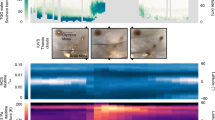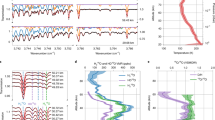Abstract
Atmospheric loss has controlled the history of Martian habitability, removing most of the planet’s initial water through atomic hydrogen and oxygen escape from the upper atmosphere to space. In standard models, H and O escape in a stoichiometric 2:1 ratio because H reaches the upper atmosphere via long-lived molecular hydrogen, whose abundance is regulated by a photochemical feedback sensitive to atmospheric oxygen content. The relatively constant escape rates these models predict are inconsistent with known H escape variations of more than an order of magnitude on seasonal timescales, variation that requires escaping H to have a source other than H2. The best candidate source is high-altitude water, detected by the Mars Express spacecraft in seasonally variable concentrations. Here we use a one-dimensional time-dependent photochemical model to show that the introduction of high-altitude water can produce a large increase in the H escape rate on a timescale of weeks, quantitatively linking these observations. This H escape pathway produces prompt H loss that is not immediately balanced by O escape, influencing the oxidation state of the atmosphere for millions of years. Martian atmospheric water loss may be dominated by escape via this pathway, which may therefore potentially control the planet’s atmospheric chemistry. Our findings highlight the influence that seasonal atmospheric variability can have on planetary evolution.
This is a preview of subscription content, access via your institution
Access options
Access Nature and 54 other Nature Portfolio journals
Get Nature+, our best-value online-access subscription
$29.99 / 30 days
cancel any time
Subscribe to this journal
Receive 12 print issues and online access
$259.00 per year
only $21.58 per issue
Buy this article
- Purchase on Springer Link
- Instant access to full article PDF
Prices may be subject to local taxes which are calculated during checkout



Similar content being viewed by others
References
Jakosky, B. M. et al. The Mars Atmosphere and Volatile Evolution (MAVEN) mission. Space Sci. Rev. 3–48 (2015).
Owen, T., Maillard, J. P., de Bergh, C. & Lutz, B. L. Deuterium on Mars—the abundance of HDO and the value of D/H. Science 240, 1767–1770 (1988).
Mahaffy, P. R. et al. The imprint of atmospheric evolution in the D/H of Hesperian clay minerals on Mars. Science 347, 412–414 (2014).
Villanueva, G. L. et al. Strong water isotopic anomalies in the Martian atmosphere: probing current and ancient reservoirs. Science 348, 218–221 (2015).
Krasnopolsky, V. A. Variations of the HDO/H2O ratio in the Martian atmosphere and loss of water from Mars. Icarus 257, 377–386 (2015).
McElroy, M. B. & Donahue, T. M. Stability of the Martian atmosphere. Science 177, 986–988 (1972).
Parkinson, T. D. & Hunten, D. M. Spectroscopy and aeronomy of O2 on Mars. J. Atmos. Sci. 29, 1380–1390 (1972).
Nair, H., Allen, M., Anbar, A. D., Yung, Y. L. & Clancy, R. T. A photochemical model of the Martian atmosphere. Icarus 111, 124–150 (1994).
Zahnle, K., Haberle, R. M., Catling, D. C. & Kasting, J. F. Photochemical instability of the ancient Martian atmosphere. J. Geophys. Res. 113, 11004 (2008).
Lefèvre, F. et al. Heterogeneous chemistry in the atmosphere of Mars. Nature 454, 971–975 (2008).
Krasnopolsky, V. A. Solar activity variations of thermospheric temperatures on Mars and a problem of CO in the lower atmosphere. Icarus 207, 638–647 (2010).
Krasnopolsky, V. A. & Feldman, P. D. Detection of molecular hydrogen in the atmosphere of Mars. Science 294, 1914–1917 (2001).
Krasnopolsky, V. A. Mars’ upper atmosphere and ionosphere at low, medium, and high solar activities: implications for evolution of water. J. Geophys. Res. 107, 5128 (2002).
Krasnopolsky, V. A. Photochemistry of the Martian atmosphere: seasonal, latitudinal, and diurnal variations. Icarus 185, 153–170 (2006).
Liu, S. & Donahue, T. The regulation of hydrogen and oxygen escape from Mars. Icarus 28, 231–246 (1976).
Lammer, H. et al. Loss of water from Mars. Icarus 165, 9–25 (2003).
Carr, M. H. & Head, J. W. Martian surface/near-surface water inventory: sources, sinks, and changes with time. Geophys. Res. Lett. 42, 726–732 (2015).
Chaffin, M. S. et al. Unexpected variability of Martian hydrogen escape. Geophys. Res. Lett. 41, 314–320 (2014).
Clarke, J. T. et al. A rapid decrease of the hydrogen corona of Mars. Geophys. Res. Lett. 41, 8013–8020 (2014).
Bhattacharyya, D., Clarke, J. T., Bertaux, J.-L., Chaufray, J-Y. & Mayyasi, M. A strong seasonal dependence in the Martian hydrogen exosphere. Geophys. Res. Lett. 42, 8678–8685 (2015).
Chaufray, J.-Y. et al. Variability of the hydrogen in the Martian upper atmosphere as simulated by a 3D atmosphere-exosphere coupling. Icarus 245, 282–294 (2015).
Maltagliati, L. et al. Evidence of water vapor in excess of saturation in the atmosphere of Mars. Science 333, 1868–1871 (2011).
Maltagliati, L. et al. Annual survey of water vapor vertical distribution and water-aerosol coupling in the Martian atmosphere observed by SPICAM/MEx solar occultations. Icarus 223, 942–962 (2013).
Fox, J. L. The chemistry of protonated species in the Martian ionosphere. Icarus 252, 366–392 (2015).
Spiga, A., Faure, J., Madeleine, J.-B., Maattanen, A. & Forget, F. Rocket dust storms and detached dust layers in the Martian atmosphere. J. Geophys. Res. 118, 746–767 (2013).
Rafkin, S. C. The potential importance of non-local, deep transport on the energetics, momentum, chemistry, and aerosol distributions in the atmospheres of Earth, Mars, and Titan. Planet. Space Sci. 60, 147–154 (2012).
Navarro, T. et al. Global climate modeling of the Martian water cycle with improved microphysics and radiatively active water ice clouds. J. Geophys. Res. 119, 1479–1495 (2014).
McElroy, M. B., Kong, T. Y. & Yung, Y. L. Photochemistry and evolution of Mars atmosphere: a Viking perspective. J. Geophys. Res. 82, 4379–4388 (1977).
Fox, J. L. & Hać, A. B. Photochemical escape of oxygen from Mars: a comparison of the exobase approximation to a Monte Carlo method. Icarus 204, 527–544 (2009).
Vandaele, A. et al. Science objectives and performances of NOMAD, a spectrometer suite for the ExoMars TGO mission. Planet. Space Sci. 119, 233–248 (2015).
Korablev, O. I. et al. ACS experiment for atmospheric studies on ExoMars-2016 orbiter. Solar Syst. Res. 49, 529–537 (2015).
Laskar, J. et al. Long term evolution and chaotic diffusion of the insolation quantities of Mars. Icarus 170, 343–364 (2004).
Anderson, D. E. Jr & Hord, C. W. Mariner 6 and 7 ultraviolet spectrometer experiment: analysis of hydrogen Lyman-alpha data. J. Geophys. Res. 76, 6666–6673 (1971).
Chaufray, J. Y., Bertaux, J. L., Leblanc, F. & Quémerais, E. Observation of the hydrogen corona with SPICAM on Mars Express. Icarus 195, 598–613 (2008).
Ramirez, R. M. et al. Warming early Mars with CO2 and H2 . Nat. Geosci. 7, 59–63 (2014).
Hunten, D. M. The escape of light gases from planetary atmospheres. J. Atmos. Sci. 30, 1481–1494 (1973).
Krasnopolsky, V. A. Photochemistry of the Martian atmosphere (mean conditions). Icarus 101, 313–332 (1993).
Deighan, J. The Effect of an Ozone Layer on Ancient Mars PhD thesis, Univ. Virginia (2012); http://libra.virginia.edu/catalog/libra-oa:2577
Sander, S. P. et al. Chemical Kinetics and Photochemical Data for Use in Atmospheric Studies Evaluation Number 17 (2011).
Lu, Z., Chang, Y. C., Yin, Q.-Z., Ng, C. Y. & Jackson, W. M. Evidence for direct molecular oxygen production in CO2 photodissociation. Science 346, 61–64 (2014).
Huebner, W. & Mukherjee, J. Photoionization and photodissociation rates in solar and blackbody radiation fields. Planet. Space Sci. 106, 11–45 (2015).
Washburn, E. W. The vapor pressure of ice and of water below the freezing point. Mon. Weath. Rev. 52, 488–490 (1924).
Matta, M., Withers, P. & Mendillo, M. The composition of Mars’ topside ionosphere: effects of hydrogen. J. Geophys. Res. 118, 2681–2693 (2013).
Woods, T. N. et al. Solar irradiance reference spectra (SIRS) for the 2008 whole heliosphere interval (WHI). Geophys. Res. Lett. 36, L01101 (2009).
Bezanson, J., Edelman, A., Karpinski, S. & Shah, V. B. Julia: a fresh approach to numerical computing. ArXiv e-prints (2014).
Damian, V., Sandu, A., Damian, M., Potra, F. & Carmichael, G. R. The kinetic preprocessor KPP-a software environment for solving chemical kinetics. Comput. Chem. Eng. 26, 1567–1579 (2002).
Acknowledgements
The photochemical model was developed with support from NASA NESSF NNX11AP49H, NASA MDAP NNX14AM20G, and a NASA Astrobiology Institute Early Career Collaboration Award.
Author information
Authors and Affiliations
Contributions
M.S.C. developed the model and performed the analysis. J.D. oversaw development of and contributed to the model. All authors contributed to interpretation of the results and their presentation.
Corresponding author
Ethics declarations
Competing interests
The authors declare no competing financial interests.
Supplementary information
Supplementary Information
Supplementary Information (PDF 444 kb)
Rights and permissions
About this article
Cite this article
Chaffin, M., Deighan, J., Schneider, N. et al. Elevated atmospheric escape of atomic hydrogen from Mars induced by high-altitude water. Nature Geosci 10, 174–178 (2017). https://doi.org/10.1038/ngeo2887
Received:
Accepted:
Published:
Issue Date:
DOI: https://doi.org/10.1038/ngeo2887
This article is cited by
-
Future opportunities in solar system plasma science through ESA’s exploration programme
npj Microgravity (2024)
-
Photochemical and radiation transport model for extensive use (PROTEUS)
Earth, Planets and Space (2023)
-
Photochemical depletion of heavy CO isotopes in the Martian atmosphere
Nature Astronomy (2023)
-
Coupling and interactions across the Martian whole atmosphere system
Nature Geoscience (2023)
-
The Mars system revealed by the Martian Moons eXploration mission
Earth, Planets and Space (2022)



